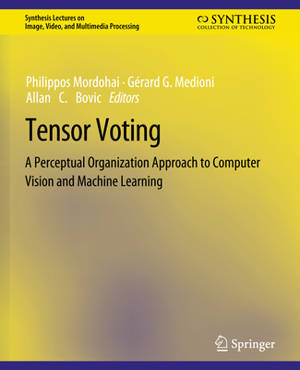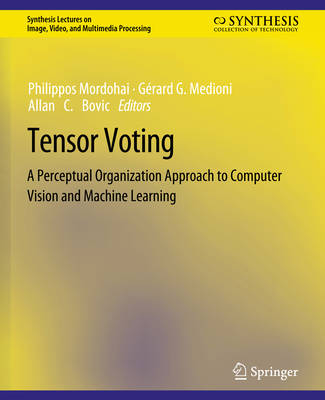
- Afhalen na 1 uur in een winkel met voorraad
- Gratis thuislevering in België vanaf € 30
- Ruim aanbod met 7 miljoen producten
- Afhalen na 1 uur in een winkel met voorraad
- Gratis thuislevering in België vanaf € 30
- Ruim aanbod met 7 miljoen producten
Zoeken
Tensor Voting
A Perceptual Organization Approach to Computer Vision and Machine Learning
Philippos Mordohai, Gérard Medioni
€ 34,95
+ 69 punten
Omschrijving
This lecture presents research on a general framework for perceptual organization that was conducted mainly at the Institute for Robotics and Intelligent Systems of the University of Southern California. It is not written as a historical recount of the work, since the sequence of the presentation is not in chronological order. It aims at presenting an approach to a wide range of problems in computer vision and machine learning that is data-driven, local and requires a minimal number of assumptions. The tensor voting framework combines these properties and provides a unified perceptual organization methodology applicable in situations that may seem heterogeneous initially. We show how several problems can be posed as the organization of the inputs into salient perceptual structures, which are inferred via tensor voting. The work presented here extends the original tensor voting framework with the addition of boundary inference capabilities; a novel re-formulation of the framework applicable to high-dimensional spaces and the development of algorithms for computer vision and machine learning problems. We show complete analysis for some problems, while we briefly outline our approach for other applications and provide pointers to relevant sources.
Specificaties
Betrokkenen
- Auteur(s):
- Uitgeverij:
Inhoud
- Aantal bladzijden:
- 126
- Taal:
- Engels
- Reeks:
Eigenschappen
- Productcode (EAN):
- 9783031011146
- Verschijningsdatum:
- 31/12/2007
- Uitvoering:
- Paperback
- Formaat:
- Trade paperback (VS)
- Afmetingen:
- 191 mm x 235 mm
- Gewicht:
- 278 g

Alleen bij Standaard Boekhandel
+ 69 punten op je klantenkaart van Standaard Boekhandel
Beoordelingen
We publiceren alleen reviews die voldoen aan de voorwaarden voor reviews. Bekijk onze voorwaarden voor reviews.











